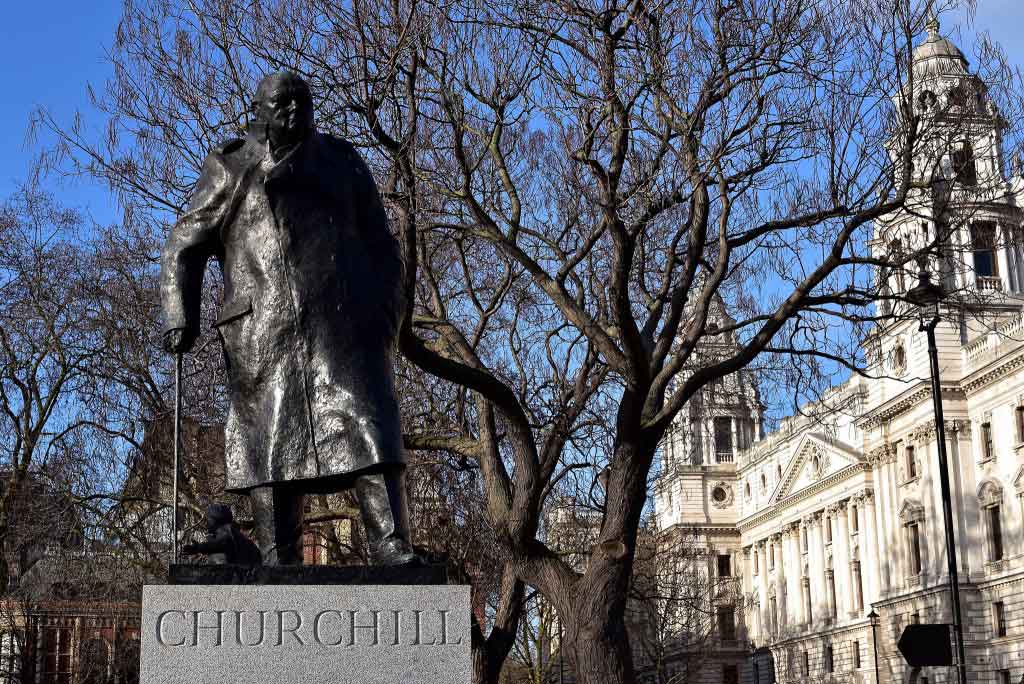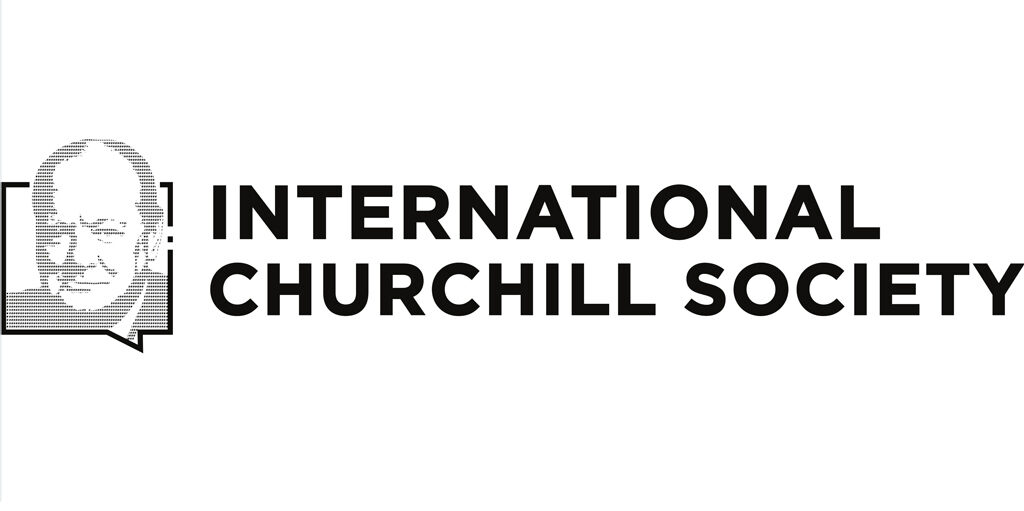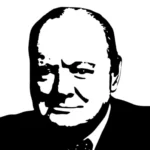
Finest Hour 143
Cover Story – Churchill in Nazi Cartoon Propaganda

Winston Churchill, Parliament Square, London © Sue Lowry & Magellan PR
June 4, 2013
Finest Hour 143, Summer 2009
Page 14
Cover Story – Churchill in Nazi Cartoon Propaganda
“I always loved cartoons,” Churchill wrote in 1931. It would have been asking a lot for him to love the ones the germans generated a few years later: A graphic reminder of what he was up against.

2025 International Churchill Conference
By Randall Bytwerk
Dr. Bytwerk is Professor of Communication at Calvin College in Grand Rapids, Michigan, and author of Julius Streicher and Bending Spines: The Propagandas of National Socialism and the German Democratic Republic. In his Landmark Speeches of National Socialism (2008) he writes: “The Germans claimed that they did not know what was happening—that was not persuasive. Everything that Nazism intended was revealed in its rhetoric. He who had ears could have heard.”
Churchill’s attacks on the Nazis are masterpieces of invective, and the Nazis returned fire. To Joseph Goebbels, Hitler’s Minister of Propaganda, he was “the biggest and most experienced liar in modern history,” and that was one of Goebbels’ gentler attacks. In Hitler’s speeches WSC was “whisky-besotted,” and he was often portrayed in Nazi cartoons with a drunk’s red nose.
Churchill’s place in Nazi propaganda varied directly with his threat level. At first he was a minor target, an irrational Englishman pushing for needless war with Germany. Between May 1940 and the invasion of Russia, he was the main enemy, the drunken demagogue at the head of British plutocracy who stood in the way of Germany’s desire for a just world order. After June 1941, he was the puppet of Roosevelt and Stalin, and the Jews who controlled them from behind the scenes: a character of the past who would ruin England in a vain attempt to defeat Germany. But Goebbels, Hitler’s propaganda minister, came to have a grudging respect for Churchill’s ability as a propagandist.
Early on, Churchill received attention only when he made the news. A December 1934 cartoon in Brennessel, the Nazi Party’s humor weekly, had him juggling false statistics on German aircraft production. Four years later, Brennessel showed Eden and Churchill sitting at the feet of Mars, who approves of their opposition to Chamberlain’s appeasement policy at Munich.1
With the outbreak of war and Churchill’s return to the Cabinet, he became a central figure. Nazi speakers were told to say that he was now an “untiring warmonger,” the chief English opponent of peace with Germany.2
Through May 1940, as First Lord of the Admiralty, Churchill was presented as the bumbling victim of German military brilliance. A January 1940 cartoon had him knocked over by a boxing ball. In April, he was shown behind bars looking hungrily at a well-stocked table, the victim of the U-boat blockade (back cover). Goebbels at that time did not think much of him, commenting in his diaries that Churchill was energetic, but rash.3
Once Churchill became prime minister, he was the personification of evil for the year when Britain stood alone against Germany. In July 1940, Goebbels ordered Nazi propagandists “to attack only Churchill and his clique of plutocrats but never the British nation as such. Churchill himself had burnt all bridges behind him so that there can be no question of any arrangement with Britain so long as he is at the helm.”4
In caricatures, Churchill was now less a clown than a criminal, a big-mouthed blowhard with nothing to back up his words. A 1940 cartoon showed a sweating Churchill awaiting the gallows, looking at a list of bombed cities. A few months later, he was being led around the world by a Jew—part of the message that as evil as Churchill was, he was only a servant of the Jews, an argument that became more pronounced after 1941.
As the Blitz mounted, Churchill was the madman who had brought ruin to England (as the Nazis always called Britain). A cartoon in November 1940 showed Churchill the “madman” watching from a window as London burned. (The Nazis didn’t realize his preferred perch was the Air Ministry roof.)
Goebbels turned up his wrath as Britain failed to buckle. His weekly columns in Das Reich, a widely circulated prestige weekly, increasingly attacked Churchill. In January 1941, he accused WSC of the Big Lie: “The astonishing thing is that Mr. Churchill, a genuine John Bull, holds to his lies, and in fact repeats them until he himself believes them.”5 A month later, Churchill was “the first violin in the hellish concert that the whole demo-pluto-cratic world is playing against the Axis powers.”6
Goebbels mocked Churchill’s claim that all he could offer was “blood, toil, tears and sweat.” It was clever propaganda, he asserted. After all, if things got bad, one could claim to have predicted it, and if things got better, one could take the credit. A cartoon soon made the point: the British lion was ill after drinking Churchill’s cocktail of blood, sweat and tears.”
Perhaps when the war is over, Goebbels speculated, Churchill would be forced to read aloud all of his speeches in public. “He would then enjoy the most original death a mortal ever had: he would drown in the world’s laughter.”7 Goebbels later wrote: “We can only be thankful that we have Churchill. One may not wish he were not there. One should take good care of him, because he is the trailblazer for our complete and radical victory.”8
Nazi propaganda suggested that Churchill was falling under American control to get the money he needed to continue the war. A 1941 cartoon had him hauling England into a Jewish pawnshop. Not only would Churchill lose the war—he would sell the Empire to the Americans in the process.
Following the invasion of Russia and the turning aside of the German onslaught on Britain, the full force of Nazi propaganda focused on Bolshevism and the Jews. Churchill now became a secondary figure. Just after the German defeat at Stalingrad, Goebbels launched a major campaign against Jewish Bolshevism. Churchill and Roosevelt were “to be presented as accomplices and toadies of Bolshevism…which is the most radical expression of the Jewish drive for world domination.”9 This theme dominated Nazi propaganda for the remainder of the war.
Churchill nevertheless remained a villain. In August 1944, a cartoon titled “Churchill’s Debts” showed him looking at the list of European cities Britain had bombed, an interesting comparison to the earlier cartoon in which he was held responsible for bombed English cities. A late 1944 mass pamphlet quoted his famous words from 1941: “Nothing is more certain than that every trace of Hitler’s footsteps, every stain of his infected and corroding fingers, will be sponged and purged and if necessary blasted, from the surface of the earth.”10 This was cited as evidence that Churchill, like his master Stalin, intended to wipe out Germany and its people.
In private, however, Goebbels gradually came to have respect for Churchill’s abilities. In December 1941, he told his associates that Churchill’s strategy of promising only “blood, sweat and tears” had been correct.11 And as the war situation turned, he increasingly followed Churchill’s example of admitting difficulties while confidently predicting final victory. Churchill, however, turned out to be the more accurate prophet.
Endnotes
1. For a wide range of Nazi propaganda on Churchill, see the German Propaganda Archive (GPA) http://bytwerk.com/gpa/winstonchurchill.htm. See also Fred Urquhart, W.S.C.: A Cartoon Biography (London: Cassell, 1955), which contains about a dozen Nazi cartoons on Churchill.
2. A translation is available on the GPA: http://www.calvin.edu/academic/cas/gpa/rim1.htm.
3. Georg Reuth, Joseph Goebbels Tagebücher 1924-1945 (Munich: Piper, 1999), 1373.
4. Willi A. Boelcke, The Secret Conferences of Dr. Goebbels (New York: Dutton, 1970), 64-65.
5. Joseph Goebbels, Die Zeit ohne Beispiel (Munich: Eher Verlag, 1941), 364.
6. Ibid., 381.
7. Ibid., 395.
8. Joseph Goebbels, Das eherne Herz (Munich: Eher Verlag, 1943), 218.
9. The document is translated on the GPA: http://www.calvin.edu/academic/cas/gpa/bolshevist.htm.
10. Heinrich Goitsch, Niemals! (Munich: Eher Verlag, 1944). A translation is available on the GPA: http://www.calvin.edu/academic/cas/gpa/niemals.htm.
11. Boelcke, 192.
Subscribe
WANT MORE?
Get the Churchill Bulletin delivered to your inbox once a month.



